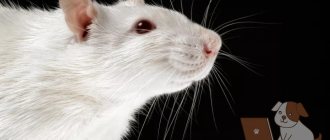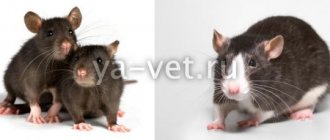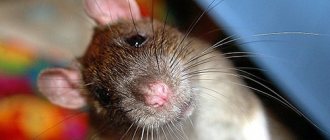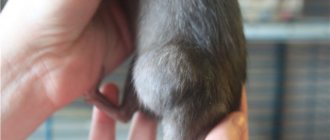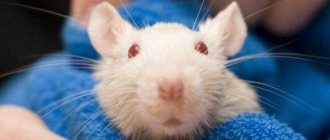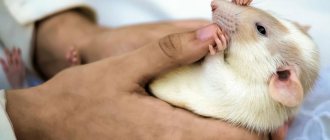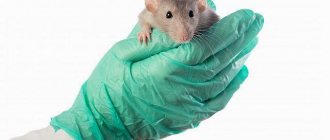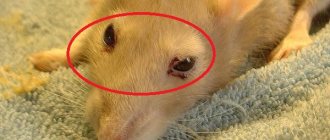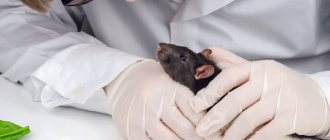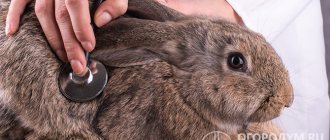The smartest and most affectionate rodent is the rat. Animals are simply amazingly intelligent. Anyone who has ever held a rat will not let you lie.
Apparently, due to their excellent mental abilities, these funny creatures are deprived of health. Tumors in rats are a fairly common occurrence. And today we will talk about what the owner should do if his pet has a neoplasm.
Signs of a tumor
What are the symptoms of tumors in pet rats? We publish a detailed list so that an attentive owner can notice the problem at an early stage of its occurrence:
- The mucous membranes become gray.
- Excessive urination and bowel movements occur.
- The pet secretes blood from the vagina, anus, urethra, and mouth.
- Hernias appear.
- The rat becomes lethargic and has no appetite.
- The pet begins to go bald. The fur is disheveled and unpleasant to touch.
- Lumps appear on the body, which can be easily felt when touched.
- Hard growths on the animal's body are possible.
If the rat owner detects such signs, then it is necessary to urgently consult a veterinarian.
Causes of tumors
One of the most common causes of tumors in rats is poor diet. The food is too fatty, poorly balanced, with a high content of dyes and preservatives.
Other reasons look like this:
- Lack of proper physical activity. If your pet lives in a cage that is too small and is often forgotten to be let out for a walk, the possibility of a tumor cannot be ruled out.
- Genetics. Unfortunately, in pets whose parents (or one parent) died of cancer, the likelihood of developing the disease is very high.
- Mycoplasmosis. There is no need to explain here, everything is clear.
- In females, the predisposition to tumors occurs at the hereditary level.
- Stress. The more discomfort the animal experiences, the higher the chance of the rat getting sick.
Medical Internet conferences
Andreeva A.A. Pharmacognostic analysis of Kirkazon clematis raw materials and its use in folk medicine // Bulletin of medical Internet conferences. 2015. Volume 5. No. 5. p.817.
Andreeva A.A., Sharkova E.A., Polukonova N.V. Comparative toxicological analysis of aqueous and chloroform fractions of extracts of Kirkazona clematis // In the collection: Medicinal plants: fundamental and applied problems Proceedings of the II International Scientific Conference. Novosibirsk State Agrarian University. 2015. pp. 179-181.
Andreeva A.A., Gelevera N.I., Sharkova E.A., Polukonova A.V., Prilepsky A.Yu., Polukonova N.V. Comparison of the activity of extracts of clematis (Aristolochia clematitis) and fireweed (Chamérion angustifolium) on SPEV-2 cell culture // Saratov Medical Journal. 2016. T.12 No. 2. P. 226.
Balitsky K. P., Vorontsova A. L. Medicinal plants and cancer. - Kyiv: Naukova Dumka, 1982. 348 p.
Baitman T.P., Navolokin N.A. The influence of auranium officinalis extract on laboratory animals with grafted sarcoma S-45 // Bulletin of medical Internet conferences. 2013. T. 3. No. 2. P. 374.
Valov R.I. Pharmacognostic study of the aerial part of Chamerion angustifolium (L.) / R.I. Valov. Ulan-Ude, 2012, - 23 p.
Goldberg E.D., Razina T.G., Zueva E.P. and others. Plants in complex therapy of tumors. Moscow: RAMS Publishing House, 2008. 229 p.
Durnova N.A., Afanasyeva G.A., Kurchatova M.N., Zaraeva N.V., Golikov A.G., Bucharskaya A.B., Plastun V.O., Andreeva N.V. Contents of markers of oxidative stress in blood plasma under the influence of extracts of auranium officinalis, sandy immortelle, anthocyanin form of corn under conditions of induced oxidative stress // Experimental and clinical pharmacology. 2015. T. 78. No. 7. P. 36-40.
Durnova N.A., Kurchatova M.N. The influence of plant extracts on the induction of micronuclei by cyclophosphamide in the blood erythrocytes of outbred white mice // Tsitology. 2015. T. 57. No. 6. P. 452-458.
Kozaeva L. T. Biological features and biochemical composition of the meadowsweet Filipendula ulmaria (L.) Maxim. and Kamchatka meadowsweet Filipendula camtschatica (Pall.) Maxim. upon introduction. Dissertation. for the job application uch. Ph.D. degrees Agricultural Sciences. 2008. 127 p.
Korman D.B. Basics of antitumor chemotherapy. Moscow: Practical Medicine, 2014. 459 p.
Korsun V.F., Korsun E.V., Lakhtin V.M., Phytolectins: a guide to clinical herbal medicine. Moscow: Practical Medicine, 2007. 380 p.
Kurkin V.A. Pharmacognosy: a textbook for pharmaceutical universities (faculties) / V.A. Kurkin. / 2nd ed., revised. and additional Samara, 2007. – pp. 1122-1123.
Kurchatova M.N., Durnova N.A., Polukonova N.V. The influence of extracts containing bioflavonoids on the induction of micronuclei by dioxidin in the erythrocytes of the blood of outbred white mice // Bulletin of Voronezh State University. Series: Chemistry. Biology. Pharmacy. 2014. No. 2. P. 58-65.
Kurchatova M.N., Polukonova N.V., Durnova N.A. Determination of the toxicity class of the Gratiola officinalis L. extract using a new test object - Chironomus riparius larvae // Toxicological Bulletin. 2014. No. 6. P. 40-43.
Maslyakova G.N., Polukonova N.V., Navolokin N.A., Mudrak D.A., Bucharskaya A.B., Tychina S.A., Korchakov N.V. Morphological changes in transplanted kidney cancer in rats with the administration of a flavonoid-containing extract of auranium officinalis // Bulletin of medical Internet conferences. 2022. Volume 7. No. 2. P. 577-580.
Navolokin N.A., Pavlova A.V. Morphological changes in muscles in laboratory rats and determination of toxicity upon administration of auran extract // Bulletin of medical Internet conferences. 2012. T. 2. No. 2. P. 82.
Navolokin NA, Polukonova NV, Bucharskaya AB, Maslyakova GN Morphofunctional changes in laboratory rats with transplanted liver cancer PC-1 after prolonged per-oral administration of flavonoid containing extracts // Bulletin of the Russian State Medical University. 2012 a. No. 1. P. 277.
Navolokin N.A., Polukonova N.V., Maslyakova G.N., Bucharskaya A.B., Tyrnov V.S. Morphological changes in organs and tumors of rats with transplanted liver cancer PC-1 after oral administration of purple corn extract (Zea mays L.) // Russian Journal of Biotherapeutic. 2012 b. T. 11. No. 2. P. 37.
Navolokin NA, Polukonova NV, Maslyakova GN, Bucharskaya AB, Durnova NA Effect of extracts of Gratiola officinalis and Zea mays on the tumor and the morphology of the internal organs of rats with transplanted liver cancer // Russian Open Medical Journal. 2012 T. 1. No. 2. P. 0203.
Navolokin N.A., Polukonova N.V., Maslyakova G.N., Skvortsova V.V., Baitman T.P., Bucharskaya A.B., Durnova N.A. Antitumor activity of plant extracts containing bioflavonoids // Russian Biotherapeutic Journal. 2013 a. T. 12. No. 2. P. 59-59a.
Navolokin N.A., Polukonova N.V., Maslyakova G.N., Bucharskaya A.B., Durnova N.A. Morphology of internal organs and tumors of laboratory rats with transplanted liver cancer PC-1 after oral administration of flavonoid-containing extracts of grasshopper (Gratiola officinalis l.) and anthocyanin corn (Zea mays L.) // Saratov Journal of Medical Scientific Research. 2013 b. T. 9. No. 2. P. 213-220.
Navolokin N.A., Polukonova N.V., Maslyakova G.N., Skvortsova V.V., Baitman T.P., Bucharskaya A.B., Durnova N.A. Antitumor activity of plant extracts containing bioflavonoids // Russian Biotherapeutic Journal. 2013 T. 12. No. 2. P. 59-59a.
Navolokin N.A., Polukonova A.V., Bibikova O.A., Polukonova N.V., Maslyakova G.N., Bucharskaya A.B. Cytomorphological changes in the culture of pig embryonic kidney cells under the influence of grasshopper extract (Gratiola officinalis L.) // Fundamental Research. 2014. No. 10-7. pp. 1369-1374.
Navolokin N.A., Mudrak D.A., Matveeva O.V., Tychina S.A., Bucharskaya A.B., Polukonova N.V., Maslyakova G.N. The influence of plant extracts containing flavonoids on the leukocyte formula and red bone marrow of laboratory rats with grafted sarcoma 45 // Advances in modern natural science. 2015 a. No. 4. pp. 134-140.
Navolokin N.A., Skvortsova V.V., Polukonova N.V., Manaenkova E.V., Pankratova L.E., Kurchatova M.N., Maslyakova G.N., Durnova N.A. Antituberculosis activity of grasshopper extract (Gratiola officinalis l.) in vitro // Experimental and clinical pharmacology. 2015 b. T. 78. No. 4. P. 10-13.
Navolokin N.A., Mudrak D.A., Matveeva O.V., Tychina S.A., Bucharskaya A.B., Polukonova N.V., Maslyakova G.N. The influence of plant extracts containing flavonoids on the leukocyte formula and red bone marrow of laboratory rats with grafted sarcoma - 45 // Advances in modern natural science. 2015 No. 4. pp. 134-140.
Navolokin N.A., Polukonova N.V., Mudrak D.A., Tychina S.A., Voronkov M.O., Korchakov N.V., Bucharskaya A.B., Maslyakova G.N. Comparison of the antitumor activity of the extract of Avran officinalis and its constituent quercetin when administered intratumorally // Russian Biotherapeutic Journal. 2015 T. 14. No. 1. P. 111.
Navolokin N.A., Mudrak D.A., Tychina S.A., Korchakov N.V. Changes in the leukocyte formula, red bone marrow and tumor of laboratory rats with transplanted sarcoma-45 with the introduction of extracts of auranium officinalis, sandy immortelle, and anthacyanic corn || Saratov scientific and medical journal. 2015, Vol. 11, No. 3, pp. 328-332.
Navolokin N.A., Mudrak D.A., Polukonova N.V., Tychina S.A., Korchakov N.V., Bucharskaya A.B., Maslyakova G.N. Evaluation of antitumor and anti-cachexic activity of grasshopper extract (Gratiola officinalis L.) in rats with grafted sarcoma // Siberian Journal of Oncology. 2016 a. T. 15. No. 1. P. 37-43.
Navolokin N.A., Mudrak D.A., Tychina S.A., Polukonova N.V., Korchakov N.V., Bucharskaya A.B. Anticachexic and antitumor activity of flavonoid-containing extract of grasshopper (Gratiola officinalis L.) on rats with grafted sarcoma 45 // Bulletin of medical Internet conferences. 2016 b. T. 6. No. 2. P. 291-295.
Navolokin N.A., Mudrak D.A., Polukonova N.V., Tychina S.A., Baytman T.P., Korchakov N.V., Voronkov M.O., Bucharskaya A.B., Maslyakova G. .N. Comparison of antitumor and anticachexic activity of flavonoid-containing extracts in an experiment on animals with grafted sarcoma 45 // Russian Biotherapeutic Journal. 2016 T. 15. No. 1. P. 72-73.
Navolokin N.A., Mudrak D.A., Tychina S.A., Korchakov N.V., Maslyakova G.N., Polukonova N.V. Pathomorphosis of transplantable sarcoma -45 with intramuscular injection of anthocyanin corn extract to laboratory rats // Saratov Journal of Medical Scientific Research. 2016. T. 12. No. 2. P. 234.
Polukonova A.V., Kuznetsova I.A., Dokalo V.E., Khasakhanova E.S., Polukonova N.V. Conditioned reflexes in different groups of animals and modifications of experimental setups in zoopsychological and preclinical tests // In the world of scientific discoveries. 2010. No. 4-10. pp. 63-65.
Polukonova A.V., Navolokin N.A., Bibikova O.A. In vitro cytotoxic activity of corvid extract on a culture of pig embryonic kidney cells infected with oncovirus // Bulletin of medical Internet conferences. 2013. T. 3. No. 2. P. 375.
Polukonova N.V., Navolokin N.A., Durnova N.A., Maslyakova G.N., Bucharskaya A.B. Method for producing dry extract from plant raw materials with biological activity // Patent for invention RUS 2482863 02/15/2012
Polukonova N.V., Navolokin N.A., Durnova N.A., Maslyakova G.N., Bucharskaya A.B. A drug with antitumor and immunomodulatory effects // Patent for invention RUS 2519769 03/21/2013
Polukonova N.V., Navolokin N.A., Raikova S.V., Yurtaeva A.V., Durnova N.A., Maslyakova G.N., Bucharskaya A.B., Shub G.M. A product with anti-inflammatory, antipyretic and antimicrobial effects // Patent for invention RUS 2535155 05/21/2013
Polukonova N.V., Navolokin N.A., Skvortsova V.V., Manaenkova E.V., Pankratova L.I., Maslyakova G.N., Durnova N.A. Agent with anti-tuberculosis effect // Patent for invention RUS 2549477 03/05/2014
Polukonova N.V., Durnova N.A., Khakhulina N.N. Phytocenoses and reserves of raw materials of grasshopper (Gratíola officinális L.) on the territory of the island of the Chardym river. Volga of the Saratov region // Bulletin of the Botanical Garden of Saratov State University. 2016. T. 14. No. 2. P. 56-61.
Polukonova N.V., Durnova N.A., Kurchatova M.N., Navolokin N.A., Golikov A.G. Chemical analysis and method of obtaining a new biologically active composition from the herb of grass grass (Gratiola officinalis L.) // Chemistry of plant raw materials. 2013. No. 4. P. 165-173.
Polukonova NV, Kurchatova MN, Navolokin NA, Bucharskaya AB, Durnova NA, Maslyakova GN A new extraction method of bioflavanoids from poisonous plant (Gratiola officinalis L.) // Russian Open Medical Journal. 2014. T. 3. No. 3. P. 304.
Polukonova N.V., Navolokin N.A., Polukonova A.V., Bucharskaya A.B., Maslyakova G.N. Culture of pig embryonic kidney cells infected with oncovirus (Spev-2) as a model object for studying the cytotoxic effect of antitumor drugs using the example of the extract of auranium (Gratiola officinalis L.) // Bulletin of medical Internet conferences. 2015 a. T. 5. No. 6. P. 926-928.
Polukonova N.V., Navolokin N.A., Raikova S.V., Maslyakova G.N., Bucharskaya A.B., Durnova N.A., Shub G.M. Anti-inflammatory, antipyretic and antimicrobial activity of flavonoid-containing extract of grasshopper (Gratiola officinalis L.) // Experimental and clinical pharmacology. 2015 b. T. 78. No. 1. P. 34-38.
Polukonova N.V., Navolokin N.A., Mudrak D.A., Prilepsky A.I., Shirokov A.A., Bucharskaya A.B., Maslyakova G.N. Study of the cytotoxic activity of auranium officinalis extract and quercetin on a cell culture of cervical cancer // Russian Biotherapeutic Journal. 2016. T. 15. No. 1. P. 88-89.
Polukonova N.V., Navolokin N.A., Maslyakova G.N., Bucharskaya A.B., Pankratova L.E., Manaenkova E.V., Kurchatova M.N., Skvortsova V.V., Durnova N. .A. Activity of grasshopper extract (Gratiola officinalis L.) against M. tuberculosis // Bulletin of medical Internet conferences 2022. Volume 7. No. 2. pp. 581-584.
Skvortsova V.V., Navolokin N.A., Polukonova N.V., Manaenkova E.V., Pankratova L.E., Kurchatova M.A., Maslyakova G.N., Durnova N.A. Antituberculosis activity of sandy immortelle extract (Helichrysum arenarium) in vitro // Experimental and clinical pharmacology. 2015. T. 78. No. 2. P. 30-33.
Plant resources of the USSR. T. 1 Flowering plants, their chemical composition, use // resp. ed. A.A. Fedorov. L.: Nauka, 1984. 464 p.
Khabriev R.U. Guidelines for experimental (preclinical) study of new pharmacological substances. M.: OJSC “Publishing House “Medicine”. 2005. 832 p.
Polier G., Ding J., Konkimalla BV, Eick D., Ribeiro N., Köhler R., Giaisi M., Efferth T., Desaubry L., Krammer PH, Li-Weber M… Wogonin and related natural flavones are inhibitors of CDK9 that induce apoptosis in cancer cells by transcriptional suppression of Mcl-1.//Cell Death Dis. 2011. No. 2. P.e182
https://www.greeninfo.ru/grassy/filipendula_ulmaria/labaznik-vjazolistnij—sopernik-aspirina_art.html
https://www.omedvet.ru/veterinarnaja_apteka/antitumor-drugs/metastop-2.html Omedvet. Phytoelite metastop
Tumors in rats
Rat diseases always worry owners. Where do tumors most often occur in pets?
- On the neck. One of the most common types of tumors. When stroking the pet, the owner notices a lump on the neck. This bump does not feel hard when touched. It rolls very easily and has a streamlined shape.
- On the mammary glands. This tumor usually occurs in females. Looks like a small bump. It glides easily under your fingers. There is no swelling, as well as firm fixation of the lump.
- Under the tail. Another type of tumor in rats is in the form of tubercles. This time - on the genitals.
- Under the paw. The lump, which initially seems small, grows very quickly. Therefore, as soon as you feel a lump under your paw, immediately contact your veterinarian.
- On the side. As a rule, it becomes noticeable only as it grows. But there are signs by which you can understand that a malignant tumor is maturing on your pet’s side. The animal becomes lethargic, and there are frequent cases of bleeding from the mouth, anus, urethra and vagina.
- On the cheek. Has your always affectionate and gentle pet suddenly become very aggressive? And while stroking her muzzle, the owner discovered an elastic ball on her cheek. And this ball rolls perfectly between your fingers. There is a high probability of neoplasm.
- Brain. Brain tumors are usually benign. But this is unlikely to make the rat owner happy. Such tumors are inoperable. The tumor can be noticed only when it has completely grown. Until this moment, it is possible to understand that a rat has a brain tumor only by external neurotic manifestations. The animal lies with its front and hind legs extended. The rat's joints do not bend.
- Bone tumors. They can be felt, and thickening of the bone tissue can be easily discerned under the fingers. Most often, these tumors lead to paralysis of the rat.
How to treat?
Are tumors in pet rats treatable? Just a few of them. And the result is not always positive. Nevertheless, let's talk about treatment.
Oncology in rats can only be treated surgically. Not all animals can be operated on. The inoperable group includes:
- Pets over three years old.
- Animals with numerous metastases.
- Rats with brain tumors.
- Pets with additional serious diseases.
In the early stages, operations are usually successful. Animals are treatable. In the later stages, most veterinary surgeons will not undertake the operation. The forecasts are too unfavorable.
Surgical intervention
Breast tumors can be removed surgically. The smaller the tumor, the easier it is to remove. Even very large tumors can be removed if the rat is determined to be in good condition before surgery and appropriate measures are taken before and after surgery to promote complete recovery.
Because breast tumors are usually located under the skin, surgery to remove them is not as invasive as major surgery that involves entering a body cavity.
If proper preoperative and postoperative care is provided, these patients usually recover fairly well. Even rats with underlying health problems, such as respiratory disease or congestive heart failure, tolerate surgery well. But only if their symptoms are controlled in advance with appropriate medications.
Veterinarians usually recommend that all female rats be neutered after mammary cancer removal. This is necessary to prevent future breast and pituitary tumors.
How it all happens
Tumors in rats and their treatment require serious efforts. Often several operations have to be performed.
Before prescribing surgery, the doctor examines the rodent. An x-ray must be prescribed in order to determine the presence of chronic diseases, as well as to exclude abscesses in the animal’s body. In addition, urine and blood are taken from the rat for analysis.
The operation is performed in a clinical setting. Only under general anesthesia. The animal is left in the hospital for at least a day so that the doctor can observe it.
We will not describe the operation itself here, so as not to cause unpleasant emotions in readers. Let us only point out that it takes place in two stages. And the seam is applied with silk threads.
What to look for
In order to promptly recognize one or another neoplasm in an animal, and accordingly, take measures to cure it, it is necessary to regularly examine the animal’s body. You should pay special attention to the following symptoms:
- The animal has become lethargic, loses appetite, weight, and has difficulty getting up from its place.
- Enlarged peripheral lymph nodes, local baldness, and the appearance of hernias.
- Impaired excretion of urine and feces.
- Refusal of food, general depression of the rodent's body, pallor of the mucous membranes.
All these symptoms may indicate cancer processes occurring in the rodent’s body, but you should not suspect a tumor for any single symptom. The final diagnosis should be carried out by a specialist after a comprehensive study; the owner’s task is to seek help in a timely manner.
Coming out of anesthesia
The owner can be with the rat as it begins to recover from the anesthesia. Just don't be afraid of its consequences. You need to be prepared for them:
- The rat is vomiting.
- She goes to the toilet on her own. Bowel movements are involuntary.
- The animal becomes aggressive, this is associated with painful sensations.
- Loss of coordination occurs. The rat moves as if in slow motion.
During recovery from anesthesia, be sure to provide your pet with access to drinking water. Many pets become thirsty during this period.
It is necessary to place a clean diaper under the animal. And change it when it gets dirty.
How to care for your pet after surgery?
For the first two or three days, the presence of the owner and constant monitoring of the pet is mandatory. The rat needs warmth, which is provided by warm water bottles. As the water cools, new water is added.
It is important to ensure that your pet does not lick the seams. To do this, use a special collar or put a blanket on the rodent.
Sometimes veterinarians recommend treating stitches and applying special ointments for faster healing. This can be done either independently or in a veterinary clinic.
We remember that only a doctor can remove stitches. Under no circumstances should we get into this matter on our own in the absence of any experience.
Symptoms
The animal must be taken to a veterinary clinic if it develops the following symptoms:
- the frequency of urination and defecation has changed significantly (up or down);
- strange scabs appeared on the surface of the rat’s skin, it began to look withered;
- the animal's fur is constantly disheveled and falls out in whole clumps;
- the rodent has stopped playing and is constantly trying to hide or lie down;
- the rat has lost its appetite and looks exhausted;
- when palpating the animal, you can feel dense lumps, swelling or bumps;
- periodically appear bloody discharge from the mouth, anus or urethra;
- the mucous membranes of the animal have an unnatural gray tint.
Even if you have several of these symptoms, do not try to make a diagnosis or choose a remedy at home yourself. The final verdict can only be made by a qualified veterinarian, who can prescribe treatment.
Preventive measures
What is the prevention of tumors in pet rats? The owner must comply with the following rules:
- Feed your pet only high-quality food. Calorie content should be low. Forget about purchasing products containing artificial colors and preservatives.
- Buy rats from trusted breeders. Nurseries value their reputation; animals purchased from them are healthy. The likelihood of being given a sick pet is very low.
- It is better to have males, they are less susceptible to cancer than their girlfriends.
- If you notice lumps, bumps, or the symptoms described above, do not hesitate to have your dog examined by a veterinarian. It is easier to prevent a cancerous tumor than to allow it to become inoperable.
Other non-surgical treatments
A compound that has been shown to treat and prevent induced breast cancer tumors in the laboratory is conjugated linoleic acid. This compound has even been shown to help rats lose weight!
When given 75 mg per day, body fat in rats was reduced by 23%. Another study found that DHEA at a dose of 6-12 mg per day protected animals from induced mammary tumors. Other studies show that curcumin, a component of turmeric, reduces the number of tumors induced in the laboratory.
Shark cartilage may also help prevent the formation of new blood vessels where tumors would grow. Treatment should begin as soon as a tumor is noticed. You can try mixing 360 mg of the product per day with food. It may work better when combined with coenzyme Q-10 (try 0.2 mg daily) and tamoxifen.
Treatment with Prednisone for some cancers other than breast cancer may slow their growth.
There is some evidence that a diet high in fat and protein is best for cancer patients. It appears that tumors may benefit from a high carbohydrate diet. You can try giving your rat soy infant formula plus extra protein and B vitamins.
